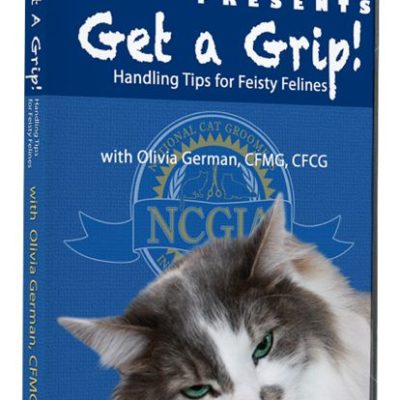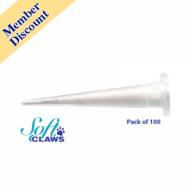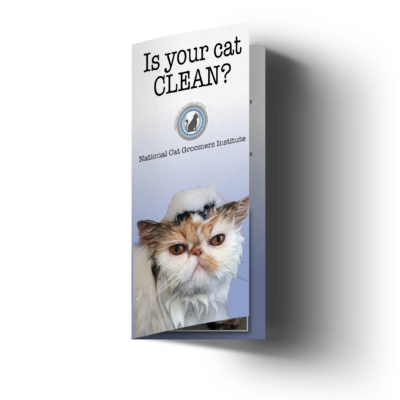By: Lynn Paolillo, CFMG, CFCG, DTS
Re-straint noun rəˈstrānt: A measure or condition that keeps someone or something under control or within limits; a device that limits or prevents freedom of movement.
Restraint is a word that is frequently used in the grooming community. Wiggly animals and sharp tools can commonly mean injuries unless some method of restraining is employed. However, restraint has come to have a negative connotation amongst cat groomers. As a result, the purpose of this article is to discuss different methods, pros and cons of each type, and recommendations of when and how to utilize each restraint while grooming and handling cats.
STOP Right There!
Far too many groomers dive right into grooming cats without first having in-depth knowledge about the behavior of these exquisite creatures. Groomers are armed with heavy gloves, multiple assistants, muzzles, and ways to tie a cat down. The most important thing to remember about grooming cats and about using restraints is that tailoring the grooming process to each cat is crucial to keep the cat and groomer safe, calm, and as stress-free as possible. But how is this done? It starts with education. This step cannot be bypassed. Cat grooming begins with an understanding of how cats think, how and why they react the way they do, and then how that will, in turn, affect each cat’s reaction to the grooming process. This is where the categories of feline temperaments come into play. While not every cat will be a textbook definition of one of the 3 temperaments, it is a starting point to discovering how best to approach the grooming process. 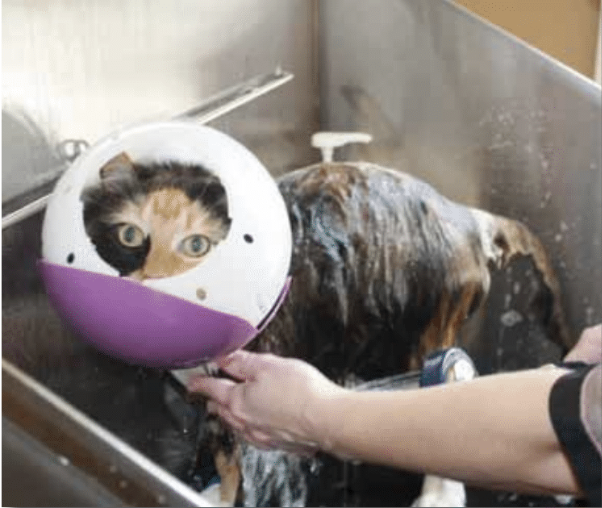
Breed and color information can also play a role in mentally preparing for each cat groom, as many times there can be similarities between cats who look the same or are from the same breeding circles or cat communities. Health conditions, anatomy, and especially symptoms of illnesses or injuries should be familiar to a cat groomer. Age can also be a factor, as older cats may be arthritic and certain techniques may be uncomfortable for them. Recognizing pain assists in making proper handling decisions, and an understanding of common health concerns helps the groomer make the best recommendations for the owner, whether it be limiting or altering grooming services, lifestyle changes for the cat at home, or consulting with a veterinarian.
A well-educated cat groomer takes all of this information and their own experience into consideration when meeting and grooming a cat not only for the first time, but for every visit. Recognizing changes in behavior can help to alert owners of illness, injury, or how changes at home can affect a cat’s mindset. Regular and open discussion with a cat’s owner will facilitate a lot of this information and will help to encourage a positive grooming experience for both cat and owner.
Types of Restraints
Once a solid background and understanding of feline minds and bodies is established, it is time to take each type of restraint into consideration. When utilizing any method of handling or restraint, always be observant of the cat’s reaction in terms of behavior, physical, or stress-level changes. If one method of restraint isn’t comfortable for the cat or the groomer, then move on to a different method. Being flexible with an individual cat will help each groomer be creative with their tools; get used to doing this by practicing on patient and calm cats in order to hone reaction times and methods for more stressed cats.
Towels – This is one of the most versatile tools to a cat groomer as it can be used in a myriad of fashions. For shy or anxious cats, they may prefer for a towel to be draped over the head while the groomer works on the back or rear end. Some feisty or even nervous cats may respond well to being wrapped up snuggly in a “kitty burrito” while having ears, eyes, and nails done. Having a towel handy can also be great when a freshly groomed cat pees, or it can be used to scoop up a frightened cat while still offering protection to the groomer. Try various techniques with rolled up towels, cats wrapped in a full or partial “burrito,” or by using it as a distraction for the cat.
Air Muzzles – One of the NCGI’s favorite tools when working with cats. But, just as with all the restraint methods, it should be used in the appropriate situation. This muzzle offers a great deal of bite protection for the groomer while still allowing a visual of the cat’s face and breathing. Even shy or nervous cats can benefit from the Air Muzzle to give them a chance to hide, or to keep the air from a dryer blowing directly into or across their face. Slowly putting the Air Muzzle over the head tends to get a far better reaction than t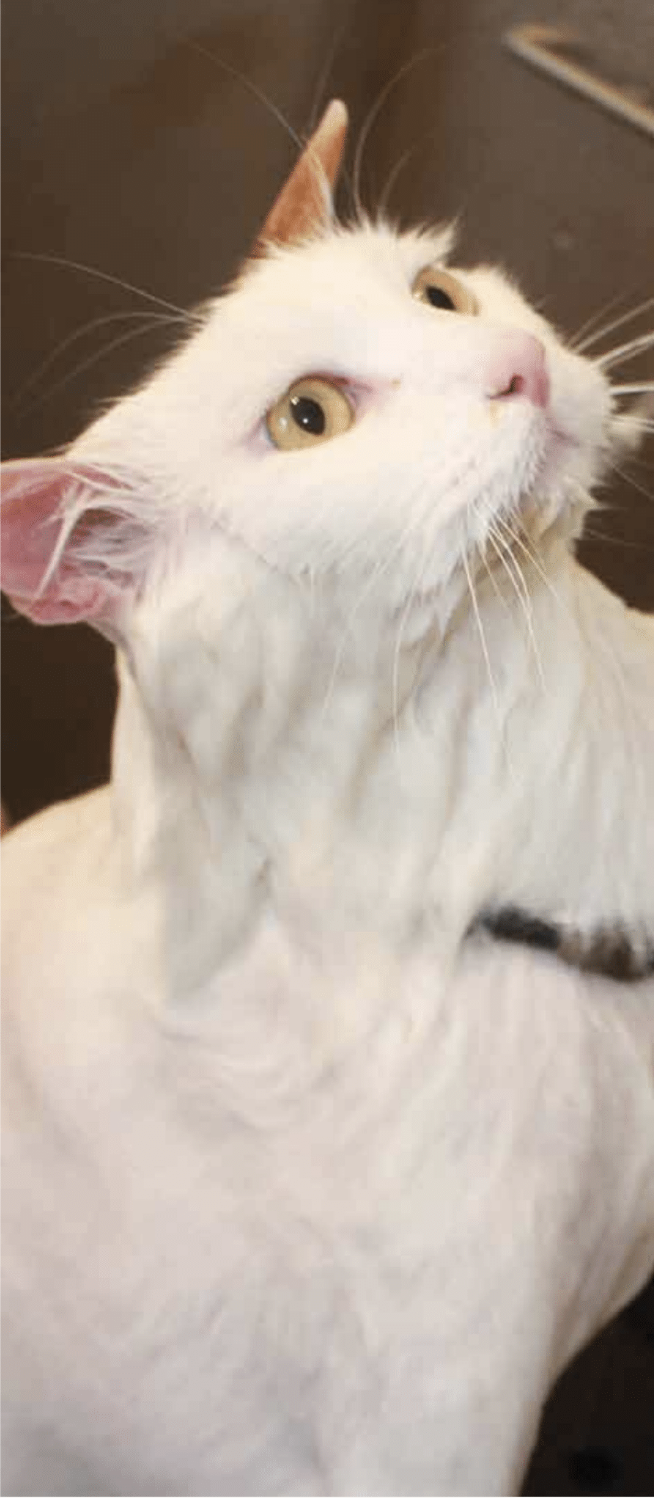 rying to quickly push it over the face. If a cat reacts poorly, usually by significant negative changes to stress levels, breathing, or any thrashing of limbs, it should be taken off and an alternative method tried.
rying to quickly push it over the face. If a cat reacts poorly, usually by significant negative changes to stress levels, breathing, or any thrashing of limbs, it should be taken off and an alternative method tried.
E-Collars – These can be used in a similar fashion to the Air Muzzle. Depending on the type of e-collar, it may not offer as much total protection for the groomer as the Air Muzzle does, but some cats will prefer the wider opening to see out of. It is important to remember that some cats, especially larger cats, will still be able to bite while wearing an e-collar, so always be observant and stay out of the bite zone as much as possible.
Nylon and Mesh Muzzles – Some cats prefer having their eyes and face covered in order to feel more comfortable in strange situations. For grooming however, these prevent the monitoring of a cat’s face and breathing, and they also offer a false sense of security against bites as cat teeth can still penetrate these materials.
Grooming Loops – Unlike dogs, these loops should never be used only around a cat’s neck. Cats are vulnerable in this area and their quick movements can mean disaster in an instant. For some squirmy cats in the tub, a loop can be used over one leg and then the head, similar to a pageant sash. This shouldn’t be used on cats trying to bite or who feel trapped with the additional holding.
Carriers – As per the definition of the word “restraint,” the cat carrier or kennel could be considered as one. In the video Kryptonite for Cats, the carrier is used as a way to keep the cat contained while water is gradually introduced to the cat’s body as a distraction for a particularly angry cat. This is a very specific technique that goes along with understanding how aggressive cats respond to water and should be used only to distract before getting the cat out of the carrier and continuing with the groom. A carrier can also be used for cats that need support while being transported, even from room to room. For example, a carrier was used to help bring a cat to and from the tub, grooming table, and drying room when it suffered from a neurological disorder that affected the cat’s balance. The cat couldn’t be carried safely, but the sturdy, flat floor of a carrier gave the cat the stability it needed.
Medications or Pheromone Sprays – Some cats respond well to a light additive that is administered by the cat owner or recommended by the veterinarian. It is important to observe the cat without any medications, catnip, or sprays in order to get an accurate read on the cat’s temperament and behavior. Not all cats find these products a pleasant experience, so they should be used like other restraints – only when appropriate for the individual cat. Administration of these products is best done by the owner in order to prevent any liability issues for the groomer. It is up to the groomer to decide if they are comfortable grooming any animal on a light sedative or medication. Any high-risk cats or heavily sedated cats should always be groomed under veterinary supervision.
Assistants – Having an additional person helping can be a blessing and a curse. It is imperative for any assistants to be well versed in cat anatomy and body movements, able to recognize signs of stress or discomfort, and able to communicate well with the groomer. Unless the groomer and assistant can work well as a team, there is a possibility of injury to both groomers and cat. 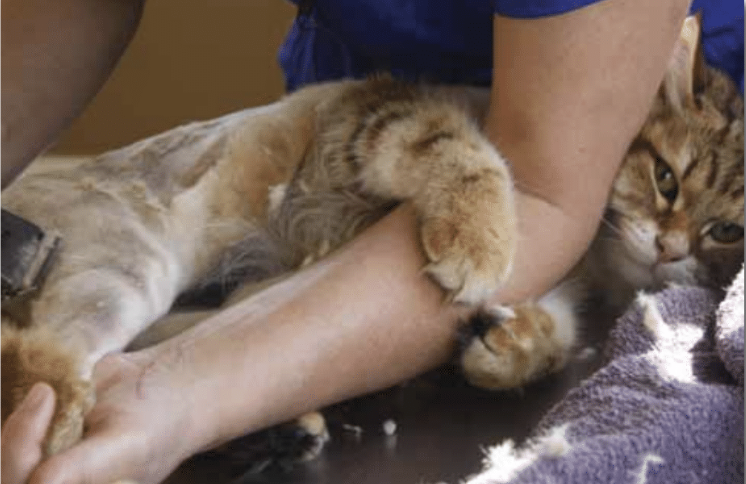
The Groomer – The body of a groomer is the best and most flexible tool to use while grooming cats. Not only is it important to understand how a cat’s body works, but each groomer should learn to be comfortable using different parts of their body while grooming. Cat groomers frequently use the hand, wrist, forearm, elbow, lap, knee, and even foot! Cats can feel more comfortable when tucked up against the groomer’s body, and the groomer can get a better feel for when a cat is uncomfortable while squirming, or if they are about to swipe or lunge. The NCGI book, Cat Handling Techniques for the Groomer, demonstrates a variety of holds using a groomer’s body. Make sure to prevent bites or scratches by staying alert and observant of a cat’s movements and anticipated movements. Many cats relax when handled comfortably by a calm and confident groomer, so less restraint can easily be used.
Scruffing
Handling the back of the neck can be done by lightly placing a hand on the shoulder area of the cat and applying a bit of pressure by using 2 fingers to slightly pinch or by using all 5 fingers in a firm grip. How this area is handled is determined by the cat’s behavior and what the groomer hopes to accomplish. It is imperative to always support a cat’s body weight and never pick up a cat solely by the scruff. The NCGI advocates this method in order to prevent a bite or to quickly adjust a fractious feline into a more comfortable position. Most often, once the cat is moved to a different position or the uncomfortable procedure (for example, shaving off painful matting) is quickly finished, scruffing is no longer needed. Each cat groomer should take into consideration all information, training, experience, and cat behaviors to determine what will be safe and effective for the cat and groomer.
Just like any of the restraints or handling methods mentioned above, scruffing isn’t always the best solution for each cat and shouldn’t be used for extended period. As groomers, we need to constantly be observing and adjusting based on the cat’s reactions instead of resorting to heavy handed “just git ‘er done” mentalities. Scruffing if commonly misunderstood when described in the context of grooming and many mistakenly assume cats are fully lifted off the table and held by their scruff. This is NOT what we are describing when using the word. Any technique that makes a cat respond negatively or escalates behavior should be reevaluated and changed for that cat, in order to foster a positive, long-term relationship with them. I personally have worked with some cats that noticeably relax with a light scruff and then over time and several appointments, I can step back from firmer handling as the cat is more acclimated to the process as a whole.
The Whole Equation
Cat grooming is not about how we can strap a cat down and make it do what we want. Grooming a cat is about solving real grooming problems while, at the same time, providing a safe and comfortable experience for the cat. Professional cat groomers must learn to know when and how to utilize each handling technique or method of restraint in a way that is conducive to a positive grooming visit.
This takes into consideration having to deal with uncomfortable and even painful situations for the cat such as severe matting, ingrown nails, irritated skin, and more. Unfortunately in these scenarios, there is only so much a groomer can do to minimize the discomfort. Sometimes this means using a bit more restraint in order to get the painful parts over quickly and safely. This also occurs during our workshops or school sessions where a beginner or training groomer may use more restraint in order to keep the risk of injury to the cat at a minimum. But as that groomer learns, practices, and becomes more confident, the level and types of restraint are usually scaled back.
Just like every cat is unique, so is every cat groomer. It takes time and practice in order to determine the best techniques to use while grooming cats, and every groomer should continue to seek out continuing education and always be observant to each cat’s experience during grooming in order to make these determinations. While not every cat will love the entire grooming process, every groomer should facilitate a safe and comfortable experience for each cat in their care.
Start your own cat grooming journey with the Complete Cat Groomer Training Syllabus and achieve your Certified Feline Master Groomer title through the National Cat Groomers Institute.

